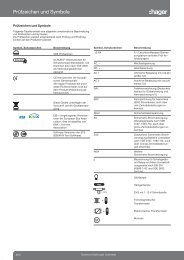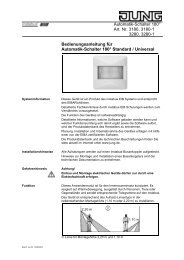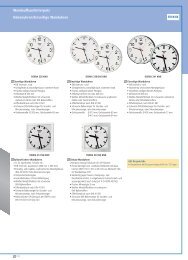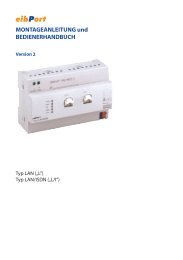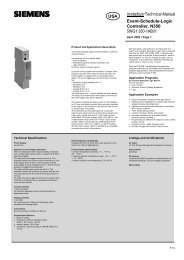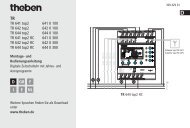You also want an ePaper? Increase the reach of your titles
YUMPU automatically turns print PDFs into web optimized ePapers that Google loves.
The following events are shown summarised in the detector list...<br />
- All the active detectors of the two security areas<br />
(Entry " + "<br />
Example: "Front door opened", "Glass break, kitchen window", "Movement in corridor"),<br />
- An active sabotage detector ("Sabotage" entry),<br />
- All the missing detectors (Entry " + "<br />
Example: "front door detector missing").<br />
An entry only remains visible in the detector list until the appropriate detector is inactive again or<br />
has been detected as present.<br />
If there are a number of active or missing detectors, the detector list may consist of several<br />
screen pages. It is possible to navigate between the pages using the function buttons shown at<br />
the edge of the screen.<br />
Detector monitoring<br />
Within a configurable monitoring period, the signalling system checks that the detectors created<br />
in the security areas exist, i.e. that they are still connected to the KNX/EIB and are functioning.<br />
For this, the panel cyclically sends a read telegram, via the group address connected to the detector<br />
input, to the bus subscriber to be tested, e.g. to the transmitting object of the binary input.<br />
This bus subscriber must then immediate send a response telegram back to the panel. This response<br />
must have reached the panel within a timeframe of 2 seconds.<br />
Should a contacted detector not respond or respond after a delay, then the signalling system<br />
will check the appropriate detector a second and - if again no response is received - a third time<br />
within a short period. If, after the third query, the detector has still not responded, a fault (in the<br />
"Unarmed" status) or in alarm (in the "Armed" status) is triggered without further delay, depending<br />
on the system status.<br />
If a missing detector causes an alarm, additional missing detectors can trigger subsequent<br />
alarms.<br />
Each detector of a security area created in the ETS plug-in is monitored in the manner described.<br />
The "Detector poll interval", which can be set in the parameter node of the signalling<br />
system, defines the time between two read telegrams, i.e. the time between two detector tests.<br />
The signalling system polls all the created detector inputs in turn in this way.<br />
Example: poll interval: 10 s, 40 detectors have been created. -> A detector is polled every 10 s.<br />
After approx. 400 s, all the detectors have been tested. After this, the cycle test is continued<br />
again with the first detector.<br />
The signalling system tests detectors considered missing cyclically at brief intervals, in order to<br />
be able to detect quickly whether or not the detector has reconnected. This is important for resetting<br />
a fault.<br />
i Detector monitoring does not take the sabotage input into account or the inputs for arming/<br />
unarming the security areas.<br />
i After switching on the power supply of the panel, or after a programming operation, the signalling<br />
system quickly tests all the created detectors during device initialisation for their existence<br />
and, during the responses, evaluates the transmitted detector statuses (active / inactive).<br />
To avoid faults in the signalling system, during panel commissioning all the detectors<br />
should have been commissioned properly and function.<br />
In addition, the detector poll may cause a delay of maximum 40 s before the signalling system<br />
is ready for arming after a device reset (precondition: all the detectors are inactive).<br />
Order-No. 7574 00 1X<br />
Software "...590101"<br />
Functional description<br />
Page 117 of 222






